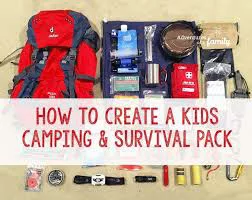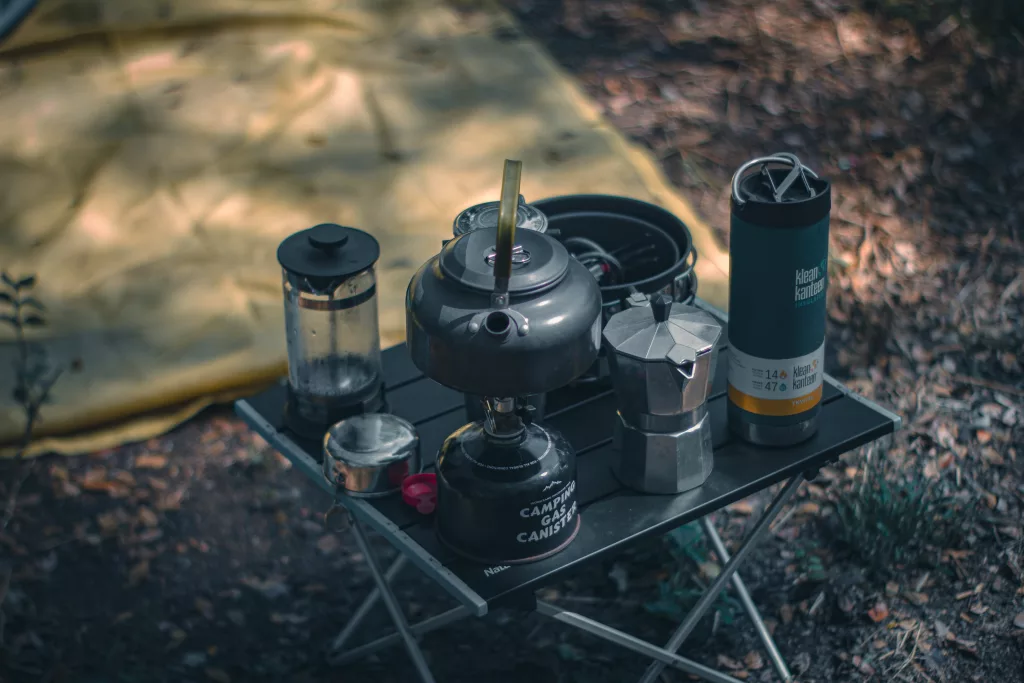Your Guide to an Unforgettable Camping Adventure
Camping calls to us with the chance of great campfires, amazing views and an opportunity to get close with nature again. But going into the wild also needs getting ready. When you’re outside having fun, something unexpected can happen. This can turn a lovely break into a challenge of strength. This is when the value of a well-made camping survival kit becomes clear.

The Essence of a Camping Survival Kit:
Picture a camping survival kit as your good friend. It’s small but helpful like an angel packed with important tools and things to help you deal with any surprises. It’s not about turning you into Rambo, but helping you feel sure and smart in dealing with small emergencies.
Try to picture walking in a heavy rain without any cover, facing a cold night with a broken sleeping bag or finding an unexpected injury away from medical help. Having a full survival kit makes you able to handle these situations easily and correctly, keeping you safe. It lets you enjoy the fun even if unexpected problems come up.
Understanding the Unique Challenges of Outdoor Adventures:
Unlike the safe place of our houses, nature can surprise us. Weather that is hard to guess, rough land and possible meeting with animals make camping trips exciting but a bit unknown. A survival kit recognizes these natural difficulties and helps you deal with them.
Imagine that you’re going through thick forests with no good tools for finding your way, being really thirsty in hot deserts without tablets to clean water, or having trouble asking for help in places where phones don’t work well. By thinking about what might go wrong and bringing the right things, you change worries into exciting chances to show how flexible and smart you can be.

Assessing Your Camping Environment:
Before you start packing your survival kit, it’s important to know the special environment of where you plan to camp. Just like you wouldn’t wear a big winter coat to the beach, making your survival kit fit for land, time of year and possible dangers helps you be ready for anything nature can happen.
Tailoring Your Kit to Different Terrains: Mountains, Mountains, Everywhere!
Each place, like big mountains or wide deserts, has its own problems. Let’s explore how to adapt your kit to conquer different terrains:
Mountain Majesty: Think tough walking shoes, sticky things for slippery ice and strong cover that can face big winds and lots of snow. Blankets for emergencies and a good stove are very important to stay warm at higher places.
Desert Dreams: Make sure to use sunscreen, have drinking water with purification tablets and a big bottle. Also, wear strong shoes to walk on sand or rocks properly. If going away from the normal path, a compass and emergency signaling tools become very important.
Forest Symphony: Buy some bug spray, waterproof clothes and a first-aid box that can handle bites or stings. A small rain protector and a useful tool with tasks like cutting and grabbing can be very helpful in thick forests.
Considering Seasonal Changes and Weather Conditions:
Camping is beautiful because you get to feel nature’s raw power, which includes dealing with its always changing weather. Let’s see how to prepare for different seasons:
Summer Sizzle: Bring easy to carry clothes, airy outfits, sun safety items such as hats and glasses. Also make sure you have enough clean water supplies. Think about using emergency cooling towels and bug spray to make yourself feel better.
Autumnal Adventures: Layers are keys! Lightweight clothing layers, a useful middle layer for warmth and waterproof outer clothes make sure you stay ready to change temperature. Don’t forget strong shoes for possibly wet and dirty paths.
Winter Wonderland: Warmth is paramount! Buy a sleeping bag with good insulation, a strong tent made for heavy snow, and warm clothes plus boots that don’t let water in. Bring a stove with good fuel and backup fire starters for nice nights near the campfire.
Pro Tip: Always look at the weather prediction for your picked days and area, and get ready if things change quickly. Bringing a little weather radio can help you know if bad storms or extreme weather situations are coming your way.
Evaluating Potential Risks in the Chosen Camping Area:
It’s always good to learn about the dangers related to where you want to camp. This helps you to pack the right way and stop things that could be avoided. Here are some aspects to consider:
Wildlife Encounters: Study the animals in your local area and know how they act. Bring bear spray if needed, and learn how to properly store food so animals don’t get attracted.
Natural Hazards: Get to know possible dangers like floods, slides of mud or fast changes in water levels. Pay extra attention when camping around rivers or lakes. It’s very important to know where you need to go and what steps you should take during an emergency.
Medical Considerations: If you or anyone with your group has any health problems, remember to bring the needed medicines and tell important people where you are. Think about bringing an emergency first-aid bag with extra stuff special for the possible dangers where you want to go.
Navigation Tools for Wilderness Exploration: Camping Survival Kit
Go into the wild with sureness, knowing you have what it takes to find your way through its twisting and turning trails. In this part, we look at important tools needed for navigation that become your compass and map to make sure you always find the correct path (or discover amazing new spots!).
Detailed Topographic Maps:
Maps showing land shapes aren’t just old things. They are everlasting treasures of information. Their detailed lines show the increase and decrease of land. They mark rivers, ravines, and important places with accuracy. Buy a good map of the place you want to camp and learn how to understand its details. You will learn about changes in height, find possible places to camp, and travel trails with sureness.
Reliable Compass for Directional Guidance:
Sometimes, even with the best map, you might need a bit more guidance. Go to the compass, your magnetic north star that you can always trust. Learn how to use it with your map to find out where you are. Then, know which way is what and stay on track even in big forests or wide open lands. Think about a compass with features such as ability to change declination and a sighting mirror for better accuracy and easier use.
GPS Devices for Precision in Modern Camping:
For people who like using technology, GPS gadgets give more help in finding your way. Pick a GPS device that has features useful for what you need. This could be maps, planning paths, or help SOS functions. Don’t forget, GPS can use up batteries quickly. So buy extra ones or a charger you can carry around to keep your digital helper working all the time.
Remember: Even though GPS devices are convenient, you still need to know how to use a map and compass. Think of them as extra tools, and always have a backup plan if technology doesn’t work.
With these navigation tools in your bag, you will beat every trail. You can explore secret areas of the wilderness and always find your way back to the warm fire at camp. Now, let’s go into the important place of cleaning water and ways to get hydrated. This is very necessary for any good camping trip to be successful.
Water Purification and Hydration Solutions: Camping Survival Kit
The heart of life runs through every blood vessel in your camping trip – water. But in wild places, getting clean drinkable water isn’t always easy. This part helps you with important ways and skills to make sure your body stays hydrated. It turns every drink into a fun way to show how smart and strong we are.
Portable Water Filters or Purification Tablets:
Picture yourself going into the middle of nature and knowing that you can change any river or lake to your own special place. Small water filters like squeeze or gravity ones remove germs, bugs and tiny plastics from any water source making it a place to get water easily. Pick a filter that fits what you need. Think about things like how much it can hold, how fast it cleans and is easy to use.
Cleaning tablets are small and easy to carry. They are good at killing bad little germs. Look into what kind of tablets work best for your chosen place and make sure you know the right amount to use and how to apply them properly.
Collapsible Water Containers for Easy Storage:
Imagine a strong, space-saving thing that changes from flat circle to water helper. Water bottles that can fold up are a good choice. They don’t leak and make it easy to carry your important water supply around with you. Pick containers based on how much you need and think about things like insulated options for hot or cold drinks or features that can filter water while you’re out.
Hydration Bladders for On-the-Go Drinking:
Picture climbing a mountain path, beads of sweat falling on your face. You grab for a nice drink without stopping. Put on the water bag, your own container strapped to your back, giving you water through an easy-to-use mouth tube. Pick a bladder size that fits your planned activity and think about things like insulated choices for hot times or bladders with bite systems for simple one-handed use.
Conclusion:
Making a camping survival kit isn’t about having every gadget you can find; it’s about fitting your readiness to the special story of your trip. By learning about where you are, picking the best tools for the task, and knowing how to use them then your kit changes from a group of things into a strong protection net. It watches over you quietly during your journey.
This guide is just the start. Go out, look around, learn and change. Try out different equipment, improve your outdoor skills and above all, enjoy the unexpected. Remember, the best things in camping trips often are not on the planned schedule. They’re waiting to be found by people ready to meet them fearless and smartly.
FAQs:
What are some vital gadgets to continually consist of in my survival kit?
Beyond the unique gear mentioned in this guide, consider packing a first-resource package, emergency fireplace starter, multi-device, headlamp, signaling reflect, whistle, restore package for gear, and insect repellent. Remember to customize your package based on your selected surroundings and private needs.
How do I learn simple survival abilities?
Many sources are to be had, from online tutorials and wilderness workshops to books and nearby outdoor golf equipment. Consider taking a fundamental survival talents path to research crucial strategies like hearth beginning, safe haven building, and navigation.
